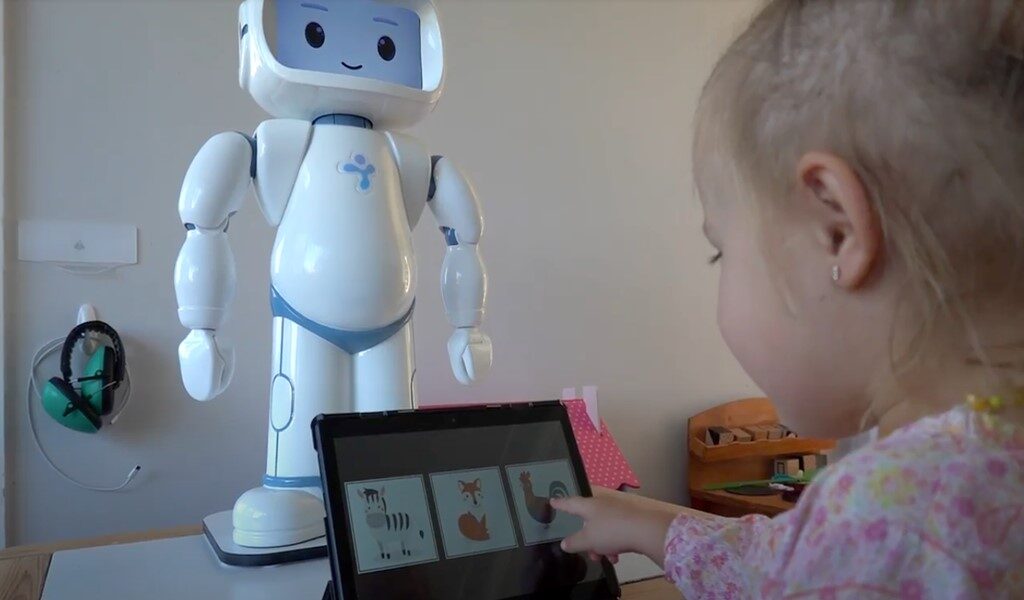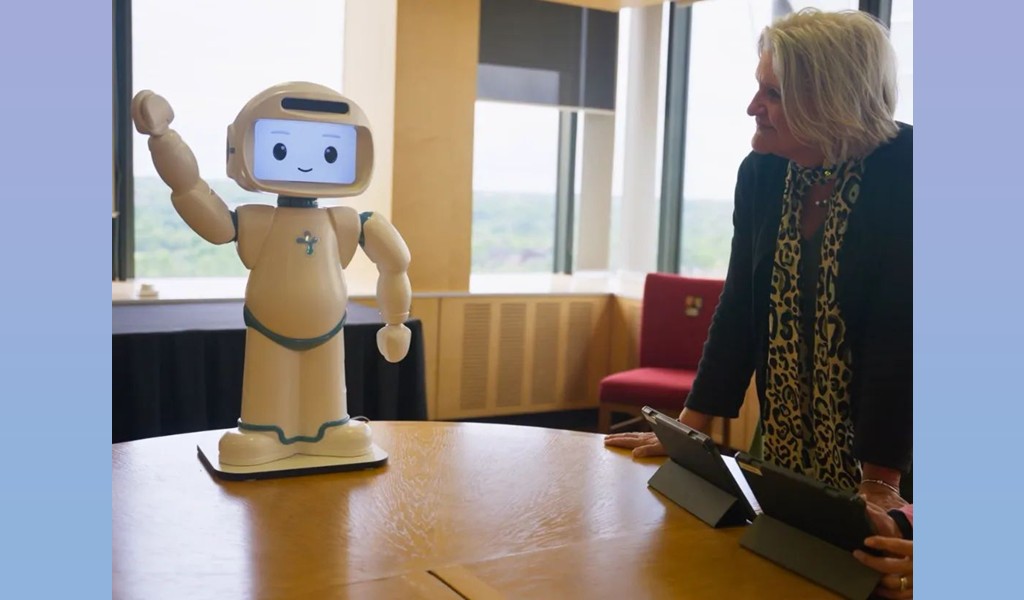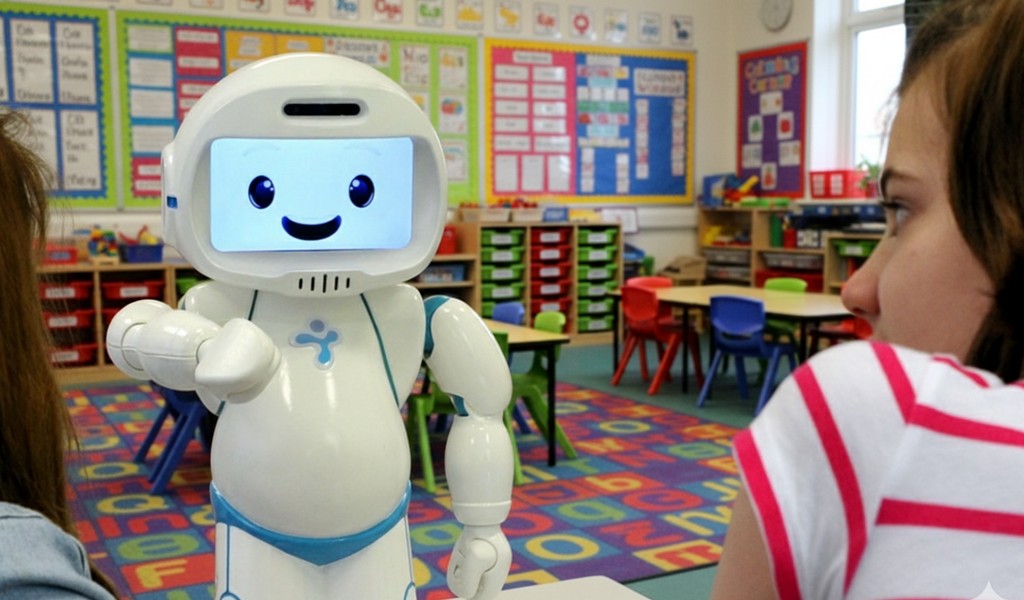Early signs of language development delays frequently lead parents to seek autism diagnosis for their children. While delays in expressive language are readily apparent, assessing receptive language—how a child comprehends spoken language—is far more subtle and complex. This complexity in evaluating receptive language in autistic children is acknowledged as a significant obstacle in creating individualized speech and language interventions tailored to each child’s specific developmental level and needs.
Robot-Mediated Receptive Language Intervention for Autistic Children, such as those offered by QTrobot, are emerging as promising avenues for not only advancing the development of receptive language in autistic children but also for the assessment and evaluation of their receptive language capabilities.
This article reviews the impact of Robot-Mediated Receptive Language Intervention for Autistic Children in a non-experimental, real-life setup.
Table of content
Objectives of evaluating the impact of robot-mediated receptive language intervention for autistic children
This study investigates the application of QTrobot for Autism in home environments by families across a 12-month period. Conducted outside of a traditional experimental framework, in real-world settings, this study provides ecologically valid insights into the robot’s effect on the receptive language skills of autistic children.
The objectives were to:
- Compare initial parental assessments of their child’s receptive language skills with the child’s actual competencies as demonstrated during robot-mediated activities conducted by QTrobot. This comparison aims to assess the accuracy of parental judgments regarding their children’s receptive language abilities.
- Assess the effectiveness of robot-mediated receptive language intervention in improving autistic children’s language comprehension. This assessment will be based on performance data collected by QTrobot throughout the period of use.
- Evaluate parents’ perceptions of the robot’s impact on their child’s development in receptive language, as well as its role in enhancing their understanding of their child’s capabilities and needs.
Robot-mediated receptive language intervention structure
Robot:
QTrobot, an expressive educational robot designed specifically to assist children with autism, was employed to administer structured, gamified interventions aimed at improving receptive language skills. Previous research utilizing QTrobot has demonstrated its effectiveness in aiding children with autism by increasing their attention and engagement, reducing anxiety and stereotypical behaviors, and boosting their motivation and collaboration during educational tasks.
Receptive Language Activities and intervention method:
QTrobot is programmed with a curriculum featuring over 400 individual activities that target various skill areas. These include social, emotional, self-regulation, cognitive skills, and both receptive and expressive language development.
The curriculum is grounded in neurodevelopmental milestones identified in pediatrics and incorporates evidence-based methods such as social narratives, Discrete Trial Training, prompting, reinforcement, visual supports, and video modeling. Each developmental milestone forms the basis of a unique unit within the curriculum, with tasks designed to help the child reach that specific milestone.
The curriculum’s receptive language activities are organized into 5 levels, with each level representing approximately one year’s worth of developmental milestones, cumulatively covering the ages from 0 to 5 years. It includes units that focus on various aspects of language development, such as commonly used nouns, adjectives, verbs, prepositions, and different types of WH questions.
Each activity begins with a gamified introduction where the robot appears to need assistance to complete a task and asks the child for help. During each unit, 8 unique questions are presented. For each question:
- If the child responds correctly, the robot reinforces this by displaying a happy facial expression and making a positive gesture, along with providing verbal praise. It also shows the correct answer once more before advancing to the next question.
- If the child answers incorrectly, the robot initiates an “Error Correction” procedure by repeating the question and offering a variety of prompts to guide the child toward the correct answer. Questions answered incorrectly are revisited to ensure the child is re-engaged with the challenging material, giving them another opportunity to practice their response.

Step 1 _ Robot asks: which robot is in the box?

Step 2 _ If the child makes a mistake, robot repeats the question, and provides visual prompt, helping the child to find the correct answer.
The robot-mediated intervention aims to facilitate the development of receptive language through multiple approaches:
- Firstly, engaging directly with QTrobot and answering receptive language questions can enhance a child’s understanding of language.
- Additionally, parents can gain insights into the structured approach to receptive language training, learning how to conduct similar exercises independently of the robot. This knowledge can enable parents to continue language practice in everyday settings, promoting the transfer of skills to real-world contexts.
Receptive Language Assessment at Baseline
Initially, parents filled out a placement questionnaire designed around early childhood neurodevelopmental milestones, rating their child’s abilities on a scale from 1 (the child cannot perform the task) to 3 (the child can consistently perform the task). Examples of questions include: “Can my child identify a specific color when named?” and “Can my child distinguish between large and small objects, both in real life and in pictures?”
Parents were instructed to rate their child’s skills conservatively. In cases of uncertainty about their child’s ability to perform a task, they were advised to choose a lower rating. This approach allowed for the evaluation of skills with the robot during intervention sessions, ensuring an accurate assessment of the child’s abilities. This method aimed to reduce the risk of overlooking early developmental milestones.
The responses to this questionnaire informed the selection of initial educational activities from the QTrobot autism curriculum, establishing a personalized education plan for each child.
Study Participants:
To evaluate the expected impact, an exploratory post-market analysis has been conducted on five families who purchased the robot in 2021 as Beta testers, when QTrobot for Autism was released for parents for the first time.
All on-boarded families already received therapy for their children. The minimum chronological age of children was 4 and the maximum was 11 years, and the developmental age of 18-24 months.
QTrobot Procedure for Conducting Receptive Language Activities
In each session, parents operate the QTrobot’s Educator tablet to choose activities based on the earlier completed parent questionnaire. The robot guides the activity, offering instructions, questions suitable for the child’s age, and visual aids to enhance learning. For developing receptive language skills, the robot displays stimuli on the Learner tablet, and the child interacts by selecting the appropriate responses.
The robot sessions are designed to involve parents actively, fostering a triangular interaction, between the child, parent, and QTrobot.
Parental involvement is pivotal, as it enables them to first observe their child’s performance, gaining insight into their strengths and weaknesses in receptive language comprehension. Secondly, it allows them to learn structured and evidence-based approaches to receptive language practice from the robot, equipping them to replicate these speech activities in the child’s everyday environment. This approach lays the foundation for the development of language skills that children can generalize and apply in various contexts.
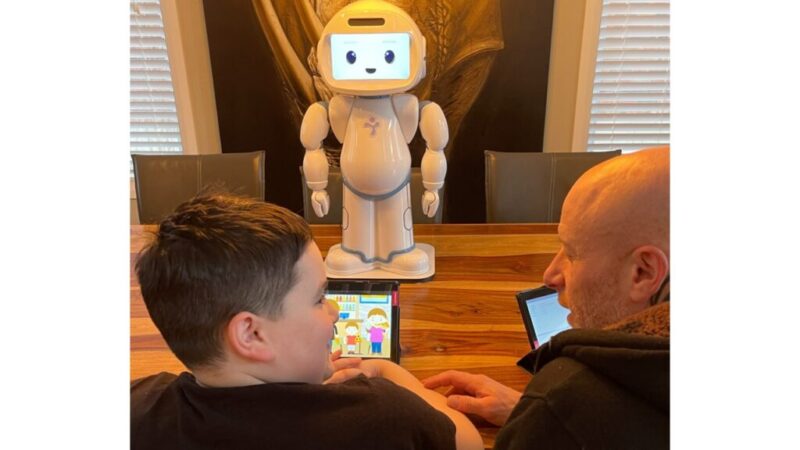
Robot mediated speech and language intervention for autism set up
When a child achieves a success rate of over 90% in responding to QTrobot’s questions across three successive sessions, the robot identifies the skill as mastered. This signals to the parents to introduce a subsequent activity from the robot’s curriculum, ensuring progression in a structured manner according to the curriculum’s design.
The robot securely gathers and stores data on each child’s task performance, keeping a detailed record of their progress while ensuring privacy. This information provides a dependable basis for objective assessments, such as evaluating a child’s receptive language skills.
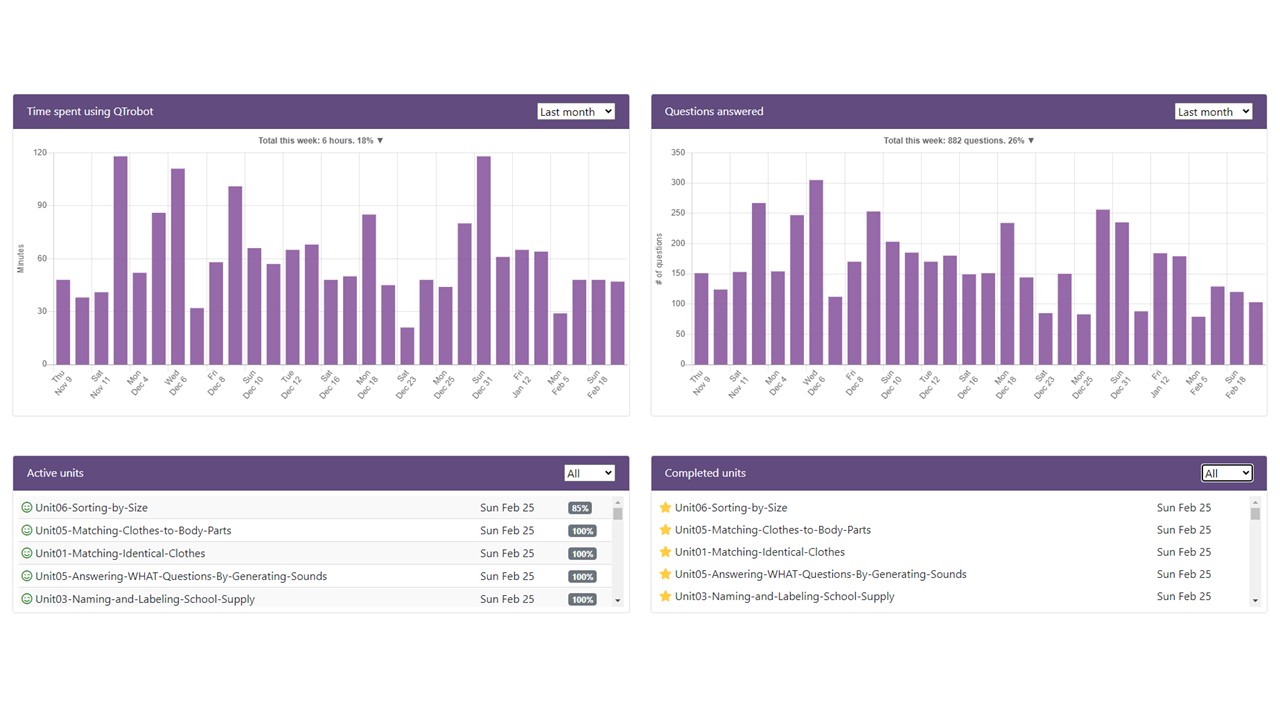
data reflecting the consistent long term use of robot mediated receptive language intervention for autism

Data reflecting efficacy of robot mediated receptive language intervention for autism
Additionally, the intervention includes various support mechanisms for parents, such as training sessions, support calls, and access to video and written materials. These resources offer guidance on extending practice beyond robot interactions, enabling children to apply and retain their skills in everyday settings.
Results of robot-mediated receptive language intervention
We use the single-subject study method to evaluate the progress of each child based on their baseline when starting the intervention according to their parent’s ranking of receptive language in the placement quiz.
We analyzed the data collected by the robot during sessions conducted at home by parents with their children. Furthermore, video statements from parents, submitted after using the robot for a period of 6 to 12 months, were reviewed to assess their perceptions of the robot’s impact on multiple aspects, such as ease of use, effectiveness on child’s learning from parents perspective and effectiveness on improving parents knowledge of the child’s developments.
Table 1 presents the average engagement with the QTrobot curriculum and its specific receptive language component by the participants in the study. The data indicates that, on average, each family engaged with 163 receptive language development questions and 585 questions covering all skill areas, including emotional, social, expressive, and cognitive skills, per month.
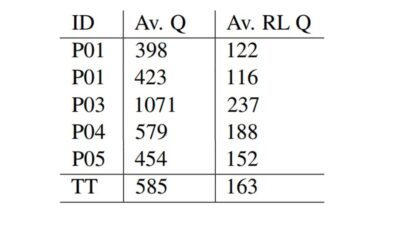
Table 1: ID: learner ID; Av. T Q: monthly average number of non-unique questions played by the earner from the entire curriculum; Av. RL Q: monthly average number of receptive language questions played. Last row: total average over selected learners.
After a year of utilizing QTrobot, all five children achieved mastery in level 3, and four of them advanced to mastering level 4. Consequently, the receptive language skills of all participating children progressed to a developmental age of up to 4 years from an initial developmental age of approximately 2 years.
The evaluation of the data collected by the robot and parents’ feedback reveals:
- All children have mastered receptive language skills, showing progress compared to their baseline evaluation. We can conclude that children can learn effectively from the robot, and they can show progress in terms of increased developmental age in the receptive language development area.
- The robot can generate reliable data related to the children’s receptive language ability, which can be used for intervention planning.
- Parents tend to misjudge their child’s receptive language skills (over- and underestimation).
- By involving parents in the sessions and allowing them to observe their children in concrete language tasks, they would be able to have a more accurate understanding of their child’s strengths and weaknesses and therefore they can be a more reliable proxy for the evaluation of the child’s language for purposes such as intervention planning.
- All parents found the robot effective in supporting them in delivering interventions and in gaining a deeper knowledge about their child’s educational and developmental status.
Conclusions
This article summarizes the findings from the long-term, non-experimental usage of QTrobot for Autism by families, highlighting its impact on receptive language development in autistic children. The data and feedback collected demonstrate that parents, regardless of their technical expertise, can effectively use QTrobot at home for structured developmental interventions.
Parents have noted that QTrobot not only supports their child’s learning but also enhances their understanding of their child’s developmental milestones and receptive language skills. Observing their child interact with QTrobot, which provides clear instructions, positive reinforcement, and prompts, offers parents deep insights into their child’s abilities and needs, empowering them to more accurately assess their child’s progress.
Furthermore, QTrobot’s features for reporting and monitoring progress help keep track of each child’s development, offering a solid foundation for objective evaluations and enabling professionals to devise personalized intervention plans.
Overall, QTrobot’s role in receptive language intervention significantly enhances parents’ capacity to support their child’s speech and communication skills development, leading to a more informed parental involvement and reducing the likelihood of misallocation of resources due to inaccurate assessments of the child’s abilities.
